Thunderbolts are the least you’d expect. A scorched sky, some localised banshee wailing, perhaps – a pathetic fallacy worthy of an ancient Greek myth.
But the weather is anticlimactically calm and clear now as the very low, very loud and very angry-looking McLaren 675LT rolls to a stop in the car park at the MIRA Proving Ground in the UK.
Waiting in the same line of marked bays is the car I’ve driven here: one of only a handful of 2015’s other new model introductions with the potential to deny the McLaren the status that Woking would claim for it. A nemesis?
Maybe not – but a rival, a kindred immortal. Something equally special, too, if not more so. Because if this McLaren isn’t the most exciting driver’s car of the year, the new Porsche 911 GT3 RS may very well be.
Both of these cars were outstanding athletes before their latest performance makeovers. Both have since been endowed with the kind of performance and handling superpowers that are normally reserved for cars with racing liveries. And right now, both are here at the start of a very special 650km, 36-hour UK road trip.
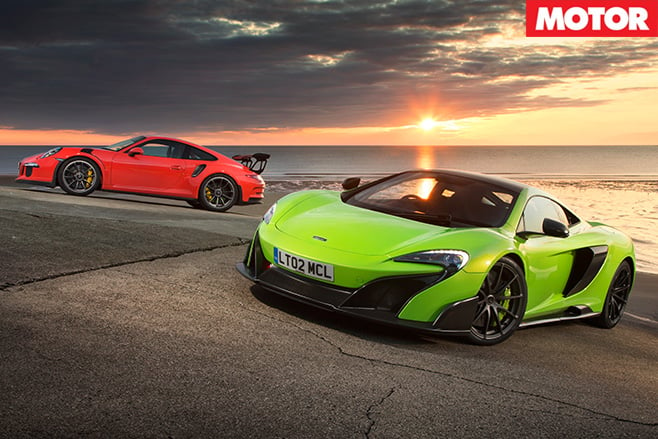
They’re both sold out. So, much as we like to imagine there’s a throng of wealthy individuals waiting with bated breath for MOTOR’s endorsement before ordering a new car, we can leave the final arguing and justifying aside.
Instead, we’ll simply find out what life on road and track is like in the company of not one but two of the most hardcore, most wanted sporting machines that this year, or any year, has to offer.
A morning of flat-out testing lies ahead at the Midlands proving ground, followed by an afternoon of photography. Then it’ll be an early evening blast north-east onto little-visited moorland roads once used by motoring journos to become acquainted with one of the McLaren’s legendary forebears.

The howl that Porsche’s flat six makes is sabre-sharp and supremely characterful. Porsche’s launch control system makes it sound all the more frenzied, governing it at high revs until the car’s gigantic 325-section rear tyres can transmit 368kW all on their own.
From inside, the car certainly feels fast – even on a wide, empty, long stretch of perfectly flat asphalt – but, like the GT3, only supercar-fast once it’s revving beyond 5000rpm.
The higher reaches of the Porsche’s rev range feel so special, though, suffused with incredible pedal response and with a visceral power delivery still building until beyond 8000rpm, that you want to stay among them whenever you can. The whip-crack changes of the excellent seven-speed PDK dual-clutch gearbox make it possible to do just that.
It’s close on swept volume, however the 675LT’s engine might as well be from a different planet. This is a compression ratio of 8.7:1 versus the Porsche’s 12.9:1, twin turbocharging versus Stuttgart’s atmospheric aspiration.
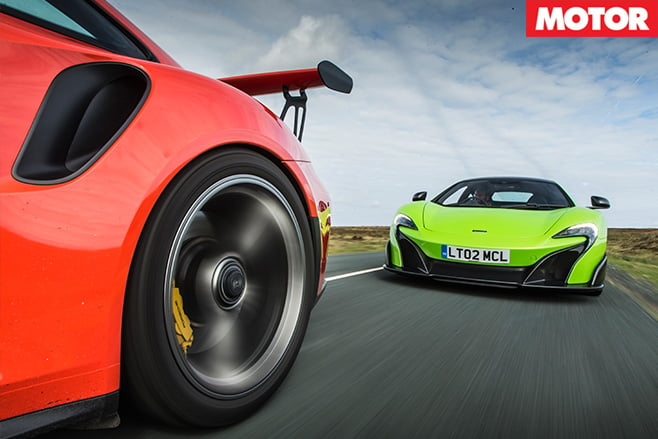
Drama is what McLaren’s sportscars need. But there is still more than a hint of turbo lag to be accounted for here at low and medium revs, just enough of it to notice when you flatten the accelerator suddenly. Perhaps not so much that it’ll be a factor on the road. We’ll see.
Once the engine has responded to that flattened pedal, though, you may not care about the preamble. The 675LT is obscenely fast – and more unconditionally so than the GT3 RS.
Like the Porsche, the McLaren revs beyond 8000rpm, but unlike the 911 it can catapult its bulk into seriously urgent motion with less than half as many revs on the tachometer. There’s enough torque to work those Pirelli P Zero Trofeo R rear tyres up into two or three successive flurries of electronically quelled wheelspin through both second and third gears – all in the dry.
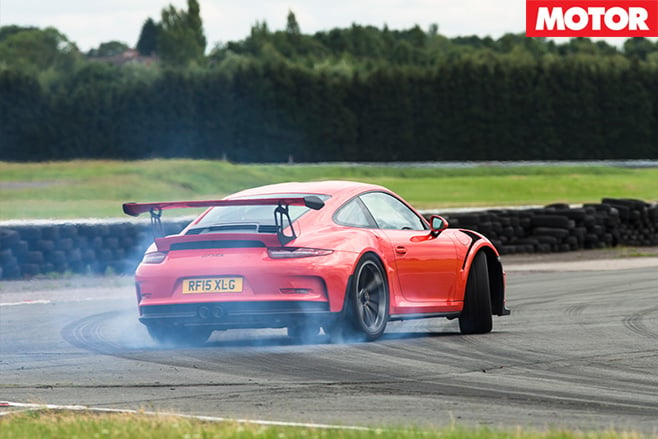
The crispness and immediacy of this car’s cornering manners are truly astonishing.
Unexpected, too, because the Porsche rides with a gentleness that you just wouldn’t imagine possible. The RS flits towards an apex with a magnetic kind of nonchalance; its every response comes more quickly than those of the regular GT3.
On the limit of grip, it has to be mastered with a quick pair of hands, but it’ll tolerate any driving style you like, fast and smooth, or more wild and unfettered. You decide. Want to nudge those 325/30 ZR21 rear tyres into a 110km/h, third-gear sweep of lift-off oversteer? Just think it, lift your right foot and it’s happening.
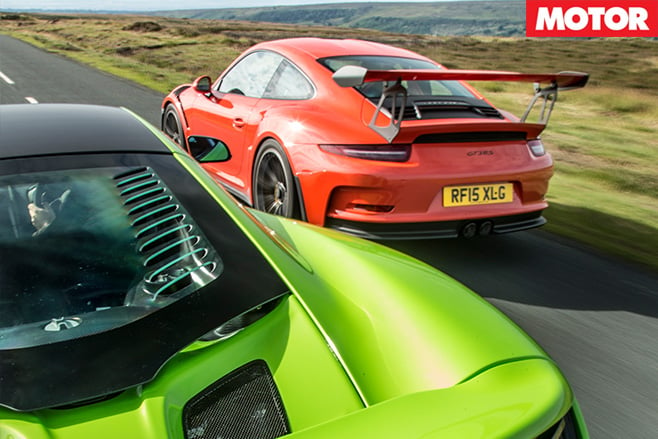
McLaren’s rebalancing of the 650S’s suspension and steering systems has paid dividends and sharpened the car’s
reactions to a fine point. There is a limpet-like, confidence-inspiring front end to lean on, along with huge reserves of lateral adhesion. After back-to-back drives in both cars, I’ve now no doubt that a P Zero Trofeo R is a stickier tyre than a Michelin Pilot Sport Cup 2.
Which is saying something.
But here on track, when you’re likely to be after a more varied driving experience than full-bore qualifying pace alone can provide, even the 675LT feels slightly one-dimensional – much as the 650S did. A softness in the accelerator pedal prevents you from tapping into those huge reserves of horsepower with quite the precision that you’d like.

When Woking launched the MP4-12C, it said the car didn’t need an E-diff. We disagreed. It said the same about the 650S – again, we disagreed. Now along comes the 675LT, still without the telling item of mechanical specification now common on sportscars at less than half the price asked for this one.
Hear us this time, please, McLaren. Because a torque-vectoring ESP system is still no substitute for the uniquely rewarding, relationship-building sensation of a sportscar being both driven and steered by its rear wheels.
The long day on track juggled between two steering wheels is drawing to a stunning close, but there’s still time for a spurt on public bitumen. And 200km on England’s busy M42, M1 and A1M motorways has provided a few insights into what real-world use of these cars would be like.
The first is that, even when battling through a sweaty rush hour with no air conditioning, questionable all-round visibility, an unintuitive navigation system and bucket seats almost as tight as your three-year-old’s safety seat, driving a lime green supercar can only ever make you smile.
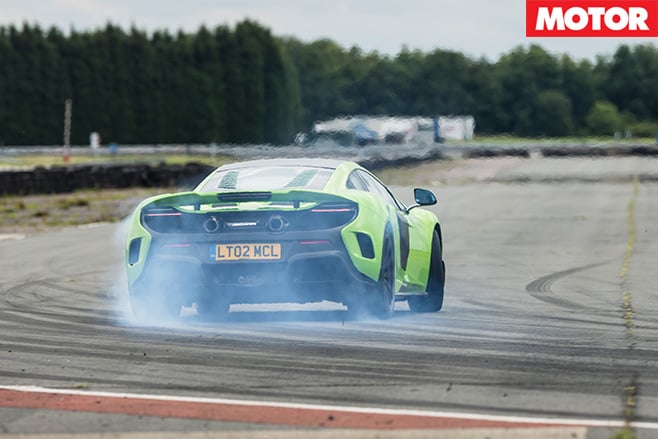
The Longtail McLaren can do that: sort of wave. Flipping its active aerodynamic functions on and off makes that extra-long rear wing waggle up and down. Children, it turns out, love it.
The busy motorway begins to gradually give way to quieter and quieter stretches, each giving our cars more space on which to stretch their legs. A mobile speed camera van came as a welcome reminder of the need for restraint when driving such cars.
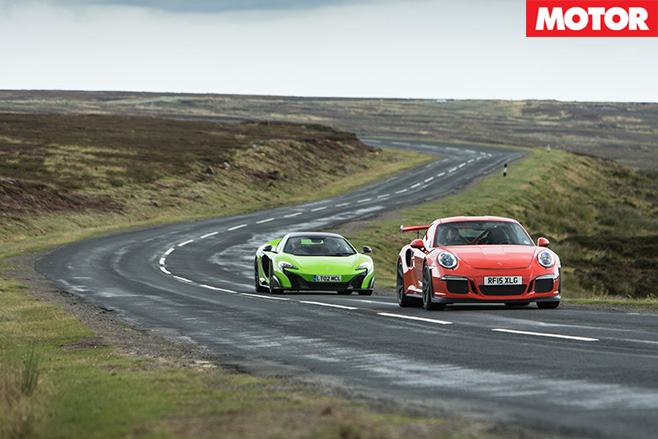
I glance in the Longtail’s rear-view mirror to check that my colleague in the Porsche is being treated to the same spectacular view, only to realise that he’s fallen a little way behind.
Later it’ll become clear why. Maintaining a fast pace in the GT3 RS isn’t hard, but it needs some commitment to the idea by staying in lower intermediate gears and allowing the engine to add a fair bit of mechanical thrash into a cabin already humming with plenty of road roar. This Porsche is very much a ‘go hard or go home’ sort of car.

When the road opens up ahead, you can flex your right foot and pick up what you imagine will be a brisk but responsible stride – then often scare yourself silly at how fast you’re travelling.
As clearly as the GT3 RS distinguished itself on the track, it’s becoming clear that the McLaren enjoys at least as big an advantage over the Porsche as a road car – and we haven’t really started with the road driving yet.
Early the following morning we are in a convoy traversing blissfully quiet roads that sometimes stretch before you for kilometres into the distance, before closing in again over crests and around blind bends. Up here, where three Ramblers and a local in a Land Rover count as the rush hour, the roads have nearly everything.
Having spent yesterday’s journey in the 675LT, I start the day in the GT3 RS, mainly to challenge the impression forming in my head that it may not be as brilliant on the road as I’d like it to be.

Steering that seemed expertly weighted and brilliantly tuned for the circuit is a bit hyperactive over a bumpy B-road. Two hands are needed on the Porsche’s downsized steering wheel at all times – and even then the car can still be tricky to guide.
The RS’s suspension doesn’t quite perfect the compromise of body control and bump absorption for fast road work, either.
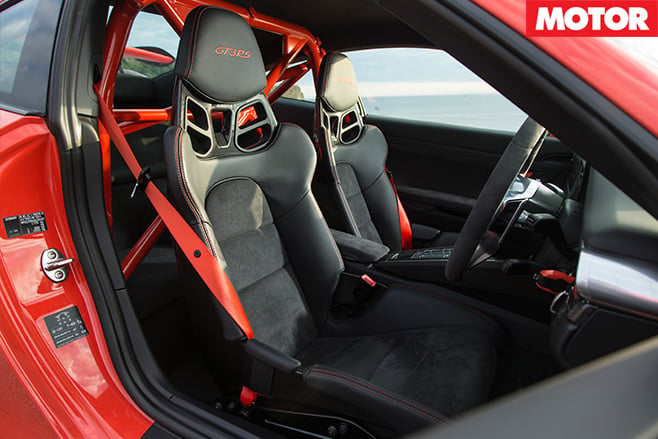
Not so the McLaren. Woking’s engineers will tell you that, even at the conception stage, the 675LT was always a road car first and a track car second.
That may seem ridiculous for something on cut slicks, dressed from head to toe in lightweight materials and capable of licence-losing velocities in a heartbeat, but it’s readily apparent, because the Longtail’s ride remains uncommonly compliant for a proper supercar, even on the most challenging of surfaces. And yet its body control is all but flawless on the road.
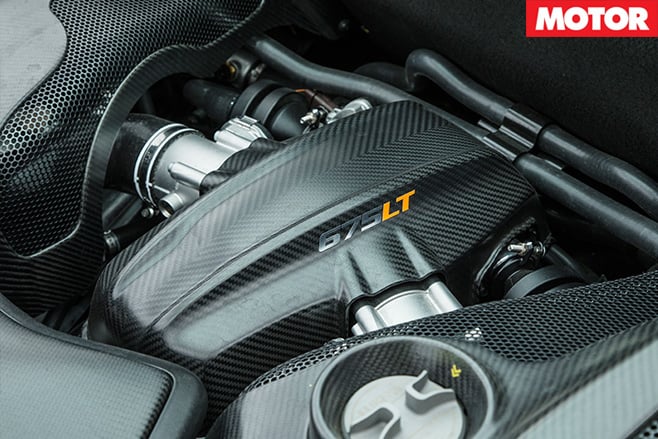
As we wrap up with our photos and think about turning for home, it’s a relief not to be ranking these cars in relative terms and not to have to pick a winner. The GT3 RS may well be the best track-day special in the world, ready for driving to and from the circuit as often as you want.
The 675LT is evidently one of the most rapid, capable and exciting performance road cars you can buy, and stands ready to entertain you on a circuit as and when the opportunity arises. They’re more different than we’d have believed 36 hours ago – and all the more brilliant because of it.
And yet it doesn’t save you or I from having the same internal conversation that any enthusiast would have before drawing a line under the story: which one of these cars is for you?
The Longtail is a harder car to connect with than the GT3 RS – and ultimately it’s probably the less rewarding to drive. The McLaren’s chassis doesn’t communicate in the same direct, vivacious, plainspeaking terms. You have to trust that it’s going to look after you as much as knowing that it will.
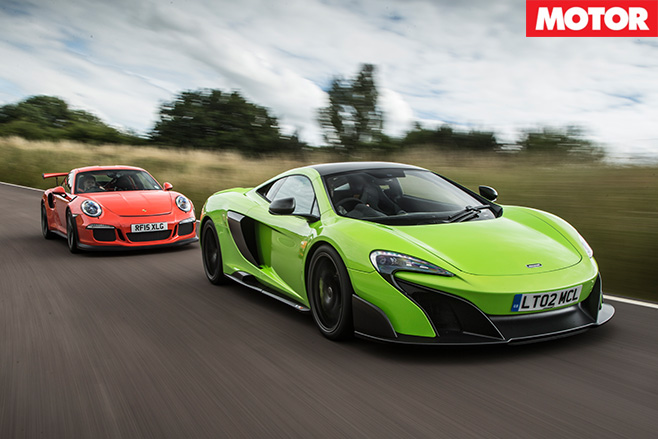
And yet, with 210km to drive home, the McLaren 675LT edges it for me.
It’s still a work in progress, but the way it combines huge, easily won pace and fluent, infallible composure on the road would be ideal for the kind of use I’d give it. Some wider sports seats for my not-so-sporting backside wouldn’t go amiss and, as I may have mentioned earlier, if there was a limited-slip diff option, I’d tick it. But I’d tick it a very happy man.
| u00a0 | u00a0 | PORSCHE 911 GT3 RS | u00a0 | MCLAREN 675LT |
| Body | u00a0 | 2-door, 2-seat coupe | u00a0 | 2-door, 2-seat coupe |
| Drive | u00a0 | rear-wheel | u00a0 | rear-wheel |
| Engine | u00a0 | 3996cc flat-6, DOHC, 24v | u00a0 | 3799cc V8, DOHC, 32v, twin-turbo |
| Bore/stroke | u00a0 | 102.0 x 81.5mm | u00a0 | 93.0 x 69.9mm |
| Compression | u00a0 | 12.9:1 | u00a0 | 8.7:1 |
| Power | u00a0 | 368kW @ 8250rpm | u00a0 | 497kW @ 7100rpm |
| Torque | u00a0 | 460Nm @ 6250rpm | u00a0 | 700Nm @ 5500-6500rpm |
| Power/Weight | u00a0 | 368kW/tonne | u00a0 | 354kW/tonne |
| Transmission | u00a0 | 7-speed PDK | u00a0 | 7-speed dual-clutch |
| Weight | u00a0 | 1420kg | u00a0 | 1403kg |
| Suspension | u00a0 | struts, coil springs, anti-roll bar (f); multi-links, anti-roll bar (r) | u00a0 | A-arms, coil springs, adaptive dampers (f/r) |
| L/W/H | u00a0 | 4545/1880/1291mm | u00a0 | 4546/2095/1188mm |
| Wheelbase | u00a0 | 2456mm | u00a0 | 2670mm |
| Tracks | u00a0 | 1587/1557mm (f/r) | u00a0 | 1676/1603mm (f/r) |
| Steering | u00a0 | electrically-assisted rack-and-pinion | u00a0 | electrically-assisted rack-and-pinion |
| Brakes | u00a0 | 380mm ventilated discs, 6-piston calipers (f); 380mm ventilated discs, 4-piston calipers (r) | u00a0 | 394mm ventilated carbon-ceramic discs, 6-piston calipers (f); 380mm ventilated carbon-ceramic discs, 4-piston calipers (r) |
| Wheels | u00a0 | 20.0 x 9.5-inch (f); 21 x 12.5-inch (r) | u00a0 | 19.0 x 8.5-inch (f); 20 x 11.0-inch (r)u00a0 |
| Tyres | u00a0 | 265/35 ZR20 (f); 325/30 ZR21 (r) Michelin Pilot Sport Cup 2 | u00a0 | 255/35 ZR19 (f); 295/30 ZR20 (r) Pirelli P Zero Trofeo R |
| Price as tested | u00a0 | $387,000 | u00a0 | $616,250 |
| Positives | u00a0 | Delicious engine; brilliantly involving dynamics; value | u00a0 | Fearsome speed; amazing comfort; supercar looks; exclusivity |
| Negatives | u00a0 | Theyu2019re all gone; puts the racer in road-racer; tyre noise | u00a0 | Almost double the GT3u2019s price; slightly aloof at the limit; sold out |
| u00a0 | u00a0 | 5 out of 5 stars | u00a0 | 5 out of 5 stars |





